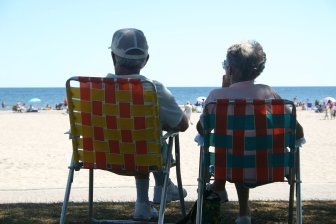Experts are preparing for the massive, messy task of removing multiple dead whales from the sea for necropsies as they investigate at least six mysterious whale deaths in the Gulf of St. Lawrence.

The North Atlantic right whale carcasses were all spotted floating near Quebec’s Magdalen Islands, a small archipelago in the Gulf of Saint Lawrence north of P.E.I. and Cape Breton.
Isabelle Elliott of the federal Fisheries Department said investigators need to find a location where they can haul the massive mammals to shore for a post-mortem examination, and are talking with a number of provinces.
“They (need) an area that is accessible by heavy equipment,” she said Monday during a news conference in Moncton.
“We need to put together a plan for towing the whales from their location in the Gulf of St. Lawrence to the appropriate location. We need to mobilize a team to do the necropsies.”
READ MORE: Six right whales dead in Gulf of St. Lawrence
They hope to conduct at least two or three necropsies, Elliott said.
Tonya Wimmer of the Marine Animal Response Society says collecting biological samples will be critical to determining what caused the deaths and hopefully prevent further losses.

Get breaking National news
The first one was spotted June 6, then June 18, and the rest in the past week.
Elliott said the number of dead whales could be higher than six, but they hope to have a firm number in the next few days.
“There have been several sightings but because these animals are actually drifting around, we have to make sure that the animals that we’re seeing are not repetitive sightings of the same animal. We will hopefully have more firm numbers in the next day or so.”
She said three of the whales have been tagged with satellite trackers, which should make it easier to find the drifting carcasses. A fourth should be tagged in the next few days.
Experts are at a loss to explain what may have killed the large whales. Right whales grow to about 15 metres in length and weigh 40,000 to 70,000 kilograms.
READ MORE: Biologists looking for answers in death of endangered right whales
Matthew Hardy of the Fisheries Department said the deaths might have been caused by a toxic algal bloom.
“It is a theory that we’re considering. We are also looking at other species that frequent those waters – birds and other fish – that can give us some indication as to whether there are signs of toxic algal blooms. We have not observed any overt signs at this time,” he said.
Laurie Murison of the Grand Manan Whale and Seabird Research Station said other reasons could include collisions with vessels or entanglement in fishing gear, as has happened several times in the last two years.
“Then there could be some other factors like toxins or something else that is happening with that population,” she said.
The string of deaths is “catastrophic” for the species, she said, and amounts to more than one per cent of the 500 North Atlantic right whales left.
“This year with having only five calves born and having six die, you’re actually going backwards with the population,” she said.
At one point in the 1930s, the population was down to only about 50 right whales, but the population has climbed back to roughly 500.
While the Gulf of St. Lawrence was once a feeding ground for the right whales, Murison said they’ve only returned there in recent years in search for food.
Aircraft and Canadian Coast Guard vessels are trying to track down the carcasses in the waters near the Magdalen Islands.







Comments